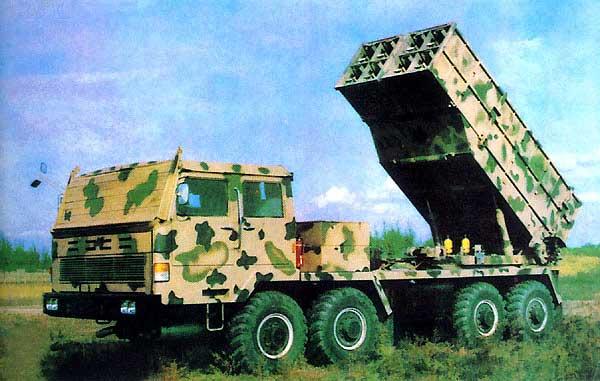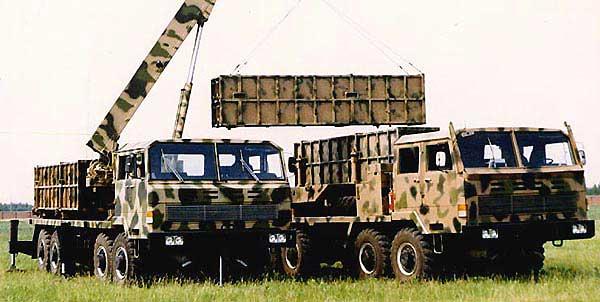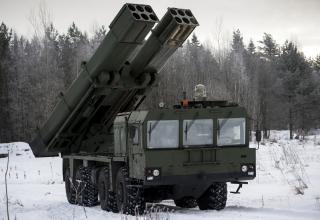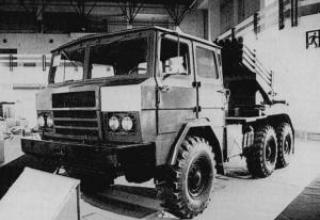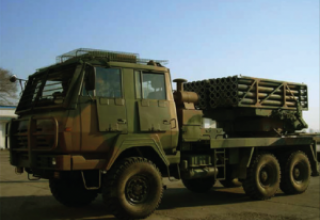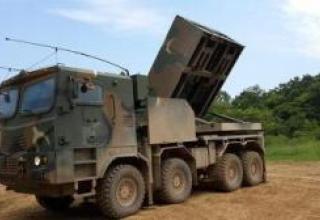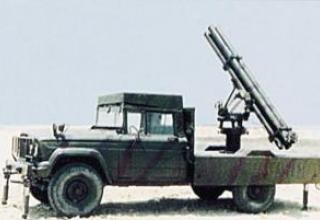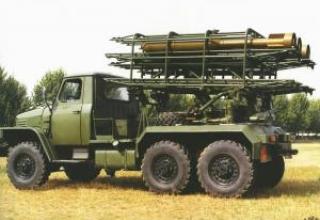The WM-80 multiple rocket launcher system is designed to engage manpower, military equipment, fortifications and control points of the enemy's administrative and population centers at ranges up to 80 km. WM-80 is the result of consistent modernization of "Type-83" MLRS. (WM-40), serial production of which began in China in 1984 by plant N123. The purpose of the modernization program was to increase the mobility and combat readiness of MLRSs, to increase the range and accuracy of firing, to increase the firing productivity, to expand the range of ammunition included in the system.
At present, WM-80 is offered for export by China North Industries Corporation (NORINCO), and there are no data on the adoption of the Chinese People's Liberation Army. Eight or four (according to different data) WM-80 systems were supplied to Armenia in 1999. The system was shipped to Bangladesh and Sudan. Four combat vehicles were sold to the US Department of Defense.
The development of the system is continuing. In 2002, a new version of the missile with extended range in uncontrolled mode (up to 120 km) was demonstrated. Active work is being done to improve the accuracy of firing, in particular, to create guided missiles for WM-80 mLRSs equipped with trajectory correction systems. This will allow the rocket artillery formations to successfully solve the tasks of accurate firing of group and single targets in any weather conditions with low ammunition consumption.
There is information about the completion of the development of a new missile of increased (406 mm) caliber, equipped with a receiver of satellite navigation system NAVSTAR. The rocket, which received the export designation "Guardian-2", has a range of up to 280 km. The increase in the missile's calibre has led to a reduction in the rocket launcher to three instead of eight in the prototype.
Composition:
The WM-80 RCDs are part of the WM-80:
- a fighting machine,
- 273mm rockets,
- fire control system
- transport-charging machine.
The starter and transport-charging machine are installed on the chassis of four-axle cross-country vehicle "Shandong Taian" TAS5380SQ (TAS5382) produced by "Tai'an Special Vehicle Manufactory" with the payload of 20t and wheel arrangement 8x8. The launcher has a pivoting frame with two packs of rocket projectiles with four guides in each. After the launch of the rockets, the packages are removed from the launcher by a special transport and charging machine and replaced by new ones. The crew of the launcher consists of five persons: the commander, the driver, the operator of the MLRS and two auxiliary numbers. The recharging process usually requires the involvement of the entire crew. The recharging time is from 5 to 8 minutes.
When driving on the highway, the launcher has a speed of up to 70 km/h and has a fairly high cross-country ability.
The principal difference between the WM-80 and the prototype is the Advanced Fire Control System (ALCS), which fully automates combat operations. After receiving a combat mission to engage, the target coordinates received via communication channels from the superior command post or manually entered, as well as the coordinates of the launcher itself (from the top linking system equipped with GPS) are transmitted to the digital ballistic computer of the LCMS. This calculator calculates the optimal installation of sights and detonators for missile warheads, taking into account weather conditions, landscape conditions and types of ammunition used. After that the launcher is automatically brought into the combat position. It can be fired in volley or single shots, depending on the choice made by the operator.
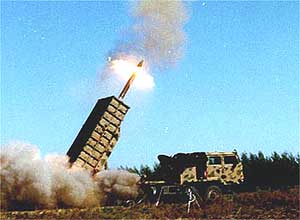
The Rocket projectile WM-80 MRXO has a classic layout, is equipped with stabilizing plumage, and is additionally stabilized in flight by rotation. Thanks to the development of a new solid propellant engine based on mixed fuel and improved aerodynamic quality, the range of the projectile was significantly increased.
It has been reported that various missile variants for the WM-80 system are being developed - an unguided missile (NUR) with a range of 80 km and a guided missile equipped with an inertial control unit and a trajectory correction system with an interference-proof receiver of the NAVSTAR satellite navigation system. The rocket movement is controlled by gas-dynamic rudders driven by high-pressure gas from the onboard gas generator. According to the information of the developer firm, the use of modern JMS provides WM-80 system with a circular probable deviation of about 800m when firing uncontrollable missiles at maximum range (ie, about 1% of the range). There is no information about accuracy of firing by guided missiles, but it can be very high.
It is also reported that a missile with an extended range of up to 120 km has been completed in unguided mode.
The WM-80 rockets are included in the ammunition package:
- The 150 kg general purpose fragmentation warhead - when detonated, it gives 16,800 fragments and has a kill radius of up to 70 meters;
- The cassette warhead to engage stockpiles of equipment, infantry fighting vehicles and other lightly armoured targets contains 380 multi-purpose submunitions with armour penetration capability of 80-100 mm.
- Thermobaric Mixed Head Unit to engage engineered fortifications and enemy manpower hidden in them.
The head units are equipped with a WJ-6A contact fuse, an MD-23A non-contact fuse or an electronic fuse 2000S. Temperature range from -40 to 50C, effective storage period - 10 years. The engine is equipped with a NTRV fuel charge weighing 205.5 kg. Descent speed of the projectile from the guide rail is 40m/s, descent time - 0.25s, maximum flight speed - 1140m/s, flight time to the maximum range - 165s, maximum height of the trajectory - 31000m.
Characteristics:
| Caliber, mm | 273 |
| Number of guides | 8 |
| Starting weight of the projectile, kg | 505 |
| Weight of BC,kg | 150 |
| Length of projectile, mm | 4580 |
| Maximum range of fire, km | 80 |
| Minimal range of fire, km. | 34 |
| Calculation, man. | 5 |
| Weight of launcher in combat position, t | 34 |
| Dimensions of the launcher, m | 9.550*3.060*3.300 |
| Recharging time, min | 5-8 |
| Power reserve, km | 550 |
| Time to transfer from camping to combat, min. | 3-5 |
| Guide lengths, mm | 4885 |
| Angle of elevation of rails, deg | between +20 and +60 |
| Angle of horizontal fire, deg | ±20 off the axis of the war machine |
Testing:
According to data dated July 2018, the Soviet side sold the rockets and other components of the Hurricane system (it is worth understanding the Hurricane MLRS) to the Syrian side. Some of these rockets were handed over to the Hezbollah movement in the early 2000s.
In 2002, Alyazhedinov Vadim Rashitovich, Skirda Viktor Andreevich was awarded the S.I. Mosin Prize for his work on the topic: "The Hurricane multiple launch rocket system with increased accuracy and heap of fire.
Sergei Sivtsov - designer of control system elements. He made a significant contribution to the development of correcting switchgears for the angular stabilization systems of Smerch and Uragan Rocket Launcher Systems. He took direct part in working out of the given elements, tests and their introduction in a batch production.
Sources:
- MissileThreat :: Guided WM-80
- Chinese Defence Today :: WM-80, 273 mm Multiple Rocket Launcher (http://www.sinodefence.com)
- Brief History of PLA's Type 83 273mm Multiple Rocket Launcher Syste
- Шунков В.Н. "Ракетное оружие" .-Мн.: ООО "Попурри", 2001- 528с.
- Гуров С.В. "Реактивные системы залпового огня". -Тула.: "Пересвет", 2006-С.260-262.
